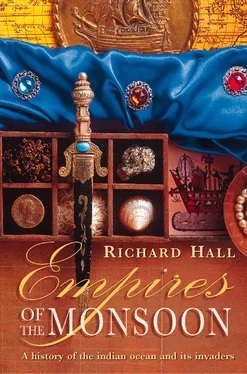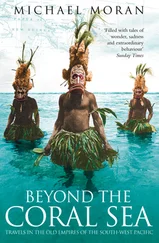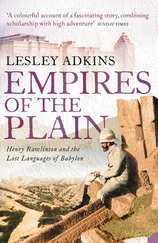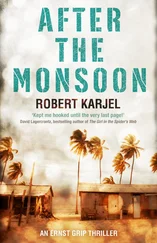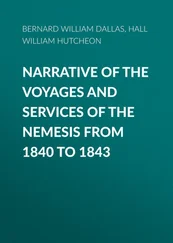1 ...7 8 9 11 12 13 ...41 Essentially, the Indonesians and the Arabs shared a similar attitude towards the African mainland – one which was predatory. The Waqwaqs brought slaves back to Madagascar to look after domesticated animals and labour in their terraced ricefields (which were built in a style identical to that found as far east as the Philippines).
In time, however, the Waqwaq impact proved beneficial in many ways: the crops they had transported from Asia included rice, bananas, yams, sugar cane, breadfruit, mangoes, lentils and spices. 5These food plants enhanced the lives of Africans right across the continent as they spread inland from community to community, starting at the coast around the Zambezi delta, which directly faced the early Waqwaq settlements on the western side of Madagascar. It is possible to re-create some of the routes by which these new crops advanced into Africa: what has been nicknamed the ‘Banana Corridor’ takes in a great swathe of land right up to the equator from near the mouth of the Zambezi. Bananas ultimately became the staple diet in Uganda, among peoples who knew nothing about the Indian Ocean or the origins of this new type of food.
The Waqwaq influence can also be traced in African musical instruments such as the xylophone, 6as well as in fishing and farming methods; a mounted file used in Madagascar for opening coconuts, as well as a double-valved bellows for blowing life into fires, are both unmistakably Indonesian.
Although they brought much to Africa that was new, the Waqwaqs became indifferent to their own past. As generations passed, the truth about their origins became merged into mythology and they grew ever more remote from the culture of Indonesia, clinging only to their language and their obsession with death and burial customs; one of these involves digging up corpses after seven years and carrying them in procession through the community, the ‘return of the dead’. As the population in the coastal regions of Madagascar became predominantly African, the Waqwaqs moved further into the mountainous interior of the great island. In the manner of colonizers elsewhere, they abandoned a skill they no longer needed, the ability to cross the open seas. Although they still buried their rulers in silver canoes, they could never go home again.
FOUR
Islam Rules in the Land of Zanj
The Zanj have no ships in which they can voyage, but boats land in their country from Oman, as do others that are going to Zabaj [Indonesia] … The inhabitants of Zabaj call at Zanj in both large and small ships and trade their merchandise with them, as they understand each other’s language.
—Al-Idrisi (1110–65), A Book of Entertainment for One Desirous to go Round the World
UNLIKE THE INDONESIANS, who forgot their original homeland after migrating to Madagascar, the Arab and Persian settlers on the East African coast always looked back to the great cities of the Middle East. They looked back quite literally, bowing towards Mecca in their mosques, where they heard the sermons of imams who read the Qur’ān and sustained their faith. The dhows sailing south to Africa on the winter monsoon brought goods which sustained their cultural links with Islam.
The earliest settlements, dating to A.D. 750 or earlier, had been rudimentary, laid out in an African style, with protective wooden palisades. Such places were too remote to make use of artisans who built in stone in the Arabic manner. Sites of the first mosques are revealed by traces of wooden post-holes in the earth, and these show a curious error: the alignment is not directly towards Mecca, as the Prophet had ruled. This suggests that the newcomers were simple traders who could not ‘read’ the night sky correctly, since their only way of finding a precise bearing was from the stars.
The logical first step for Arab newcomers was simply to install themselves in an established African fishing village, near a bay where boats could be safely run up on the beach at high title for unloading and loading. In such places, nameless and ungoverned, life was ruthless. As well as the threats from within an encampment, there was always the danger – with nobody to call upon for help – of surprise attacks by seaborne raiders. One settlement in the Comoro islands, far to the south, was built on top of a cliff, through fear of the Waqwaqs from nearby Madagascar.
It was not only to protect themselves from one another that the rival settlers tended to live on islands. They had good reason to maintain a safe distance from the Africans of the mainland. Several early communities chose islands more than a day’s sailing out in the ocean, such as Zanzibar, Pembra and Mafia, all big enough to be self-supporting in times of war. African dugout canoes, used for fishing inside the coral reefs, could not reach such islands to retrieve captives, and there was no risk that newly-acquired domestic slaves might try swimming back to shore.
Safe on their islands, the Arabs never wished to venture into Africa. They merely waited for the products of the interior to come to them. At their backs the mainland was a brooding and hostile giant, whom none cared to challenge. Local women taken as wives or concubines, and the slaves working in the gardens, were converted to Islam. 1But there was no attempt to spread the faith within Africa – its people remained kafirs .
After a few generations the settlements grew more prosperous and secure. Bigger mosques were built, and although still of wood they were now on a true alignment to Mecca. When trading ships came over the horizon from the Gulf and the Red Sea, the settlers could afford to barter for many luxuries. By the ninth century they were eating off Chinese floral-pattern plates, as well as oriental stoneware and opaque white porcelain. These outposts could tap into trade routes reaching all the way, through cities such as Siraf, to the great ports of Tang China.
The settlers also possessed pottery and glass goblets from Persia, phials containing attar of roses, many household ornaments, and brass oil-lamps. Their combs were made of tortoiseshell, cosmetics were kept in carved copper bowls. They stored their water in tall pottery jars, originally used to transport oil and wine from the Persian Gulf.
In exchange for these reminders of a distant splendour, the settlers had more than gold, ivory and slaves to offer. There were leopard-skins used on saddles, rhinoceros horns for making medicines, and the buoyant pale blue ambergris – as valuable, weight for weight, as gold – which the winds and currents swept up on to the sandy beaches. The ambergris was used to ‘fix’ perfumes, and for scenting the oil in lamps: a tenth-century poet writes of the way ‘gilded lamps, fed with ambergris, shine like pearls’.
The Chinese in particular valued this mysterious substance which, apart from its other qualities, was vaunted as an aphrodisiac; yet they did not know exactly where the ambergris came from, and named it ‘dragon’s spittle’. (The Zanj people simply called it ‘treasure of the sea’.) In fact, it was an excretion of solidified fluids, sometimes as big as an ostrich egg, from the stomachs of the sperm whales which in those times abounded in the Indian Ocean.
As the Muslim pioneers grew even richer they began building with coral stone and bricks carried from Persia as ballast. Orange and lemon orchards and vegetable gardens were planted round their homes. The animal enclosures contained sheep, goats and even camels.
The sea itself was a ready supplier of food, although some species were gradually hunted into oblivion along the East African coast. An early victim was the dugong, a large harmless mammal living on sea plants. It was often to be seen basking on coral rocks, and from a distance could look almost human, so that it became the source of many Arabic tales about mermaids. By A.D. 1000 the dugong had vanished for ever from the western side of the Indian Ocean.
Читать дальше
